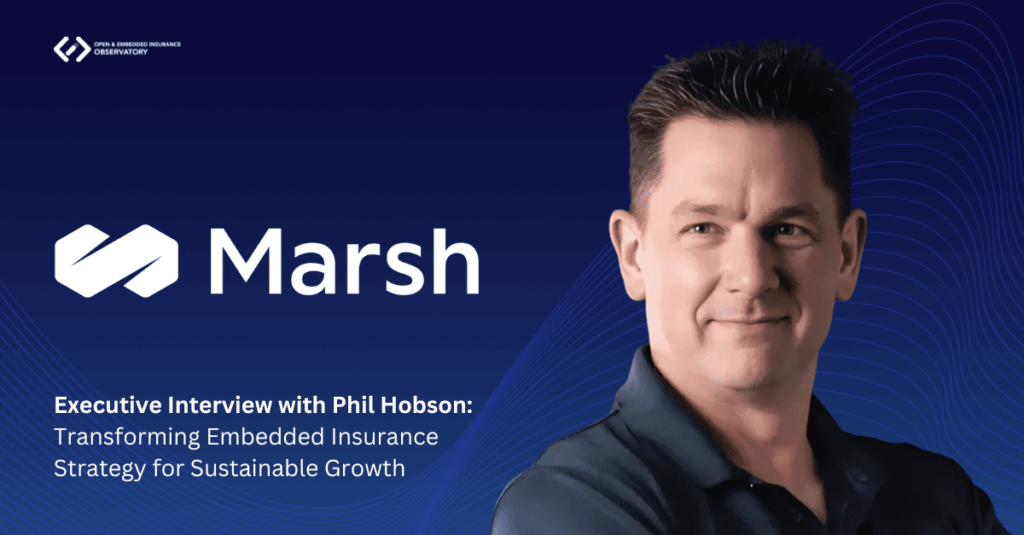Executive Summary
The Affinity practice at Marsh, operating across 66 countries with a dedicated affinity team of 1,400 professionals, stands at the forefront of embedded insurance innovation. As a leading broker and consultant in affinity marketing—particularly within automotive, equipment and consumer electronics, and financial institutions—Marsh has pioneered transformative approaches to embedded insurance distribution.
In this comprehensive interview, Phil Hobson, Managing Director, International Affinity at Marsh, discusses strategic imperatives for companies seeking to capitalize on embedded insurance opportunities, addressing common pitfalls, innovative distribution models, and scalable growth strategies.
Strategic Foundation: Moving Beyond Traditional Models
Q: What fundamental errors do organizations make when approaching embedded insurance?
Hobson: The embedded insurance sector has historically suffered from a perception problem. For decades, the market was dominated by low-quality offerings—what I characterize as “junk insurance.” Traditional models focused on superficial add-ons: credit card sign-ups bundled with generic travel insurance, or similar disconnected propositions where consumers failed to perceive meaningful value between the core product and the protection offered.
The paradigm shift requires organizations to abandon transactional thinking—the quick revenue generation mindset—and embrace a more sophisticated strategic approach. Success demands a comprehensive ecosystem analysis, asking the fundamental question: “How can we meaningfully enhance our clients’ lives?” This evolution transforms embedded insurance from a simple revenue stream into a mechanism for elevating the entire customer experience.
Case Study: Cyber Insurance Innovation
Q: Can you provide a concrete example of this strategic transformation?
Hobson: Consider the cyber security landscape. In our executive forums, universal awareness of cyber threats contrasts sharply with minimal personal cyber insurance adoption. This disconnect stems from traditional cyber insurance being prohibitively expensive or difficult to obtain.
Our solution involved strategic product integration. Recognizing that One-Time-Password vulnerabilities represent a tangible, understood risk for digital wallet and credit card users, we developed cyber coverage bundled directly with credit card products. This approach creates an intuitive connection—consumers immediately understand how their card usage relates to cyber protection. The proposition resonates because it addresses a specific, relatable vulnerability rather than offering abstract cyber coverage.
This methodology demonstrates how understanding customer pain points enables distribution of products that would be challenging to sell through traditional channels.
Market Expansion Through Customer-Centric Design
Q: How does creative thinking translate into sustainable growth opportunities?
Hobson: Growth materializes when organizations genuinely understand how to improve customer experiences. This customer-centric approach creates access to markets previously considered unreachable.
Consider our sports association partnerships. For a seven-year-old participating in a sports, injury risk is inherent, yet individual insurance purchase is impractical. By embedding coverage within membership structures, we address real protection needs while the sports association enhances member value propositions.
The embedded insurance concept isn’t revolutionary—it’s existed for decades. However, contemporary success requires starting with client needs: identifying pain points, enhancing loyalty, and leveraging existing product portfolios and distribution mechanisms to augment core offerings. When solutions address genuine problems, customers recognize and value the protection provided.
Leveraging Scale for Market Penetration
Q: How can organizations utilize scale advantages to drive sales growth?
Hobson: Embedded insurance typically offers superior cost efficiency, enabling access to previously uneconomical market segments. Our collaboration with a company that blocks unwanted calls and messages exemplifies this principle. With billions of registered profiles and sophisticated caller identification capabilities, the company provides an ideal platform for fraud protection services.
We developed a tailored fraud protection product for their premium tier rather than deploying a generic offering. The key breakthrough was cost efficiency—delivering protection at sub-$10 to sub-$20 price points, impossible outside embedded models. Traditional insurance distribution might require $100 in administrative costs just for policy processing, rendering such products economically unviable.
The scale of the company transformed the economics, creating a sustainable model that encouraged subscription upgrades while providing meaningful customer protection.
Overcoming Third-Party Retail Challenges
Q: How can brands maintain embedded insurance opportunities when distribution occurs through third-party retailers?
Hobson: Third-party retail distribution presents significant challenges by interrupting direct customer relationships. When laptop manufacturers sell through retailers, they forfeit point-of-sale insurance opportunities to intermediaries.
However, innovative solutions exist. QR code-enabled warranty registration creates post-purchase customer connections. Upon product receipt, customers scan QR codes to register warranties, establishing direct communication channels. This enables brands to offer complementary coverage—perhaps three months of free protection—initiating ongoing customer relationships with upselling potential.
This approach demonstrates how creative problem-solving can establish brand-consumer connections despite distribution obstacles.
Client Education and Market Development
Q: How well do Marsh clients understand embedded insurance growth potential?
Hobson: Understanding varies significantly across our client base. Some organizations demonstrate sophisticated ecosystem awareness, while others approach us with preliminary concepts requiring collaborative development.
Using a sports club example: initial discussions might focus on basic accident coverage. However, comprehensive family need analysis often reveals expanded opportunities—perhaps the same child participates in Girl Guides or other sports activities. Our research methodology identifies additional protection areas where value would be appreciated.
We maintain collaborative client relationships focused on strategic idea generation and market opportunity identification.
Geographic Expansion Strategies
Q: How does embedded insurance facilitate expansion into traditionally challenging geographic markets?
Hobson: Embedded insurance creates pathways to previously inaccessible territories. Our agricultural parametric insurance initiative demonstrates this capability. We developed a concept for rainfall deficit coverage for farmers in regions like Latin America , where direct sales approaches would be economically prohibitive.
Working with local financial institutions to offer poverty-alleviation loans enabled coverage democratization by utilizing portfolio scale to reduce unit costs substantially.
Similarly, our insurance program with a super-app addressed market penetration challenges. The super-app’s platform, offering 20+ services including ride-hailing and delivery, enabled coverage distribution to motorcycle delivery riders, including those with limited literacy. This collaboration unlocked previously impenetrable market segments.
Automotive Sector Opportunities
Q: What growth opportunities do you identify within the automotive industry?
Hobson: Automotive represents a natural embedded insurance fit. Our comprehensive research, conducted with the Open & Embedded Insurance Observatory, explores aftersales marketing potential extensively.
Telematics data enables personalized coverage based on individual driving behaviors. The Insurance Institute for Highway Safety found that AI-powered feedback systems addressing behaviors like heavy braking and excessive speed achieved 50% reductions in risky driving patterns. Supporting statistics include 20% crash reductions and 40% decreases in risky driving events.
We anticipate substantial automotive growth, with manufacturers, trade associations, and franchise networks developing sophisticated embedded insurance propositions leveraging these technological capabilities.
Product Relevance and Market Boundaries
Q: When pursuing growth opportunities, how distant can the connection be between core products and embedded insurance offerings?
Hobson: Meaningful connections remain essential. Automotive purchases wouldn’t logically include mobile phone insurance, but common pain point resolution provides the linking mechanism.
Consider luxury timepieces: repair insurance addresses one customer concern, but theft protection represents a more significant gap. High-end watches often exceed standard household insurance coverage limits, creating protection gaps. Our specialized watch coverage addresses this specific need while enabling jewelers to maintain annual customer touchpoints through policy renewal and service appointments.
We address focused pain points—perhaps narrow in scope but significant for affected customer segments.
Technology Investment Considerations
Q: How should brands approach potential technology costs associated with embedded insurance initiatives?
Hobson: Technology costs shouldn’t represent growth barriers. While some insurance partners charge for technology infrastructure, Marsh operates differently. We employ transparent, pre-agreed models including percentage commissions, success-based structures, or fixed upfront fees.
Marsh doesn’t charge for technology—we’re not a technology company. We prefer revenue-sharing arrangements because alignment produces superior outcomes. For bundled products without direct revenue streams, we work within existing cost structures.
Effective partnerships can make products viable at low monthly premiums. Technology investment concerns shouldn’t impede growth initiatives when approached strategically.
Implementation Framework
Q: What initial steps should distributors take when developing embedded insurance concepts?
Hobson: Organizations should begin with direct consultation. We review concepts comprehensively, often reframing initial inquiries to ensure strategic alignment.
Rather than focusing on budget allocation—clients frequently ask about optimizing million-dollar investments—we prioritize strategic questioning: What outcomes do you seek? Who represents your ideal customer? What defines your most profitable customer segment? Is it tenure-based or immediate profitability-focused?
Through layered inquiry, we identify complex implementation issues requiring resolution before concept development. This methodical approach ensures comprehensive problem-solving and strategic alignment.
We embrace patient, trust-building relationships. While revenue generation remains important, Marsh’s philosophical commitment centers on democratizing access to relevant insurance coverage—a mission worthy of sustained effort
Conclusion
The embedded insurance sector presents unprecedented opportunities for organizations willing to embrace customer-centric strategies and innovative distribution models. Success requires moving beyond traditional transactional approaches toward comprehensive ecosystem thinking, where embedded insurance becomes integral to enhanced customer experiences rather than superficial add-ons.
Through strategic partnerships, technological innovation, and deep customer understanding, organizations can unlock new markets, improve customer loyalty, and create sustainable competitive advantages in an increasingly digital marketplace.


